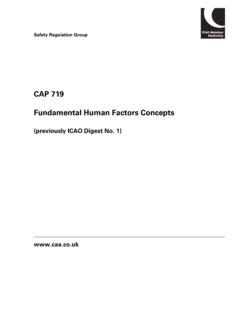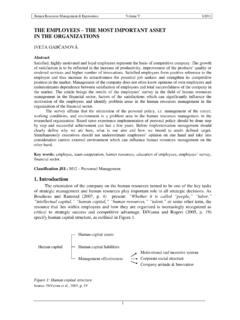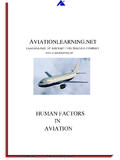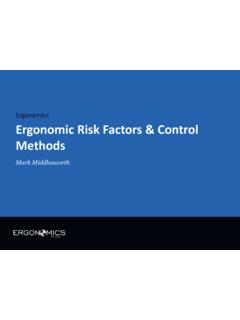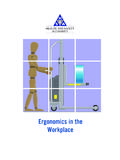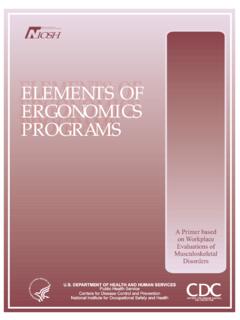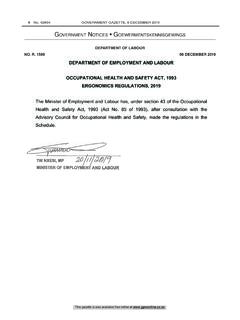Transcription of Human Body Mechanics, Ergonomics and the workplace
1 Human Body Mechanics, Ergonomics and the workplace This material was produced under a Susan Harwood Training Grant #SH-24896-13-60-F-6 from the occupational safety and health administration , Department of Labor. It does not necessarily reflect the views or policies of the U. S. Department of Labor, nor does mention of trade names, commercial products, or organizations imply endorsement by the U. S. Government. Objectives: Identify how the Human body works and its limitations. Understand the dangers associated with lifting heavy loads, uncomfortableor odd positions, repetitive movements and the use of vibrating tools(musculoskeletal disorder).
2 Understand the concept of Ergonomics . Create a comprehensive plan to prevent musculoskeletal 1: Icebreaker Muscle strengthening exercises We will do muscle strengthening exercises with the participants. Between each exercise, the facilitator will throw the ball to a participant who will have to answer a question the facilitator will ask. That participant can then throw the ball to another person and so on. This activity will serve as a pre-test, as well as teach participants how to do muscle strengthening exercises that will help them perform better in their jobs.
3 Introduction: Tell participants that many of the aches we feel in our bodies are related to the type of work we do. You can remind them of the body mapping exercise if necessary. Our posture, how we move, overexerting our muscles, the time spend in one position (be it sitting or standing), or being in an awkward position are all factors that cause physical disorders and injuries depending on the type of work we do. These types of ailments are called musculoskeletal disorders and they can affect the muscles, joints, tendons, ligaments, bones and nerves. Since most jobs require the use of our arms and hands, the majority of disorders affect the hands, wrists, elbows, neck and shoulders.
4 The use of the legs for work tasks can lead to problems in the legs, the hips, the knees, the ankles and the feet. Problems of the back also can be the result of work. These types of disorders usually generate little by little, either by the work itself or because of the working conditions. These ailments can also be caused by previous accidents in which you've fractured or dislocated a bone. Explain to the participants that in order to understand why our body hurts with certain positions and movements, it is important to understand the mechanics of the Human body. Activity 2: Mechanics of the Human Body The Locomotor System.
5 Notes for the facilitator: During this activity we will explore the basics of how the body s locomotor system works with the use of a video of the Human body and the parts that are affected by work. The locomotor system is made up of the skeletal system, the muscular system and the nervous system, which are the nerves, muscles, bones and joints. The bones provide rigidity to the body and protect vital organs. The joints allow us to flex certain parts of the body. The muscles help us move. The nervous system helps us to motivate and control our movements. Notes for the facilitator: This is the text to the video, which is designed to give participants a visual of the musculoskeletal system so that they can see the parts in their bodies that get hurt.
6 There are approximately 206 bones that make up the skeleton in the Human body. These have many functions, such as protecting our vital organs and supporting us. At the ends of the bones are highly polished surfaces covered by cartilage, which serve to articulate with neighboring bones. The central part and the ends of the bones are joined by cartilage. The joints are responsible for joining our bones, which allows us to flex and rotate some parts of our body. They are like very tough rubber bands that unite our bones. In addition we have muscles, which are fibers that shrink and stretch to help us have mobility.
7 The nervous system is responsible for the coordination and stimulation of muscles to produce movement. Activity 3: How is our movement system damaged? When our musculoskeletal system is damaged, these injuries are called musculoskeletal disorders (MSDs). They are basically a variety of conditions that affect the muscles, bones, and joints. The severity of MSDs can vary and they occur mainly in the back and the upper and lower extremities. Let's explore some of the factors that cause musculoskeletal disorders (MSDs). Ask participants if they have ever felt pain during work because of the position in which they perform their tasks, the pressure at work, or the type of work they do.
8 Allow participants time to think about each question and whether they have felt pain, then ask them to raise their hands. Give them time to respond and then explain the factors that can lead to MSDs. 1. The organization at work: Pace of work Intensity Work load Time pressure Stress No pauses and breaks Repetitive work 2. Tasks, equipment and tools: Apply intense force Apply moderate force repeatedly Repetition of fast movements Short working cycles Awkward or forced postures Muscle inactivity, immobility and sedentary work Poorly designed workspace, or workspace not adapted to the task Inadequate tools Lack of space Messy work areas 3.
9 Work environment conditions: Insufficient or excessive ventilation Noise Illumination Vibrations Cold weather Hot weather 4. Individual characteristics of the worker: Age Sex Physical complexion Physiological state Right or left-handed Absence or insufficiency of training Many of these disorders are acute and painful while others are chronic and long lasting while also being painful. These are some of the symptoms: Pain in specific parts of your muscles or joints. Rigidity occurs with more frequency in the nape of the neck, back and shoulders.
10 Sensation of tingling, numbness and stiffness on the limbs. Burning sensation. Loss of strength. Loss of ability to grip objects. Loss of feeling in the affected area. Continuous muscle fatigue. Loss of coordination. Limited ability to move the affected area. Let s explore the hazards that cause damage to our movement system: Notes for the facilitator: Using pictures, explain each of the positions and movements that our bodies have to do at work based on the following descriptions. Then ask participants to respond whether they think the position or movement can hurt the person or not and why.










